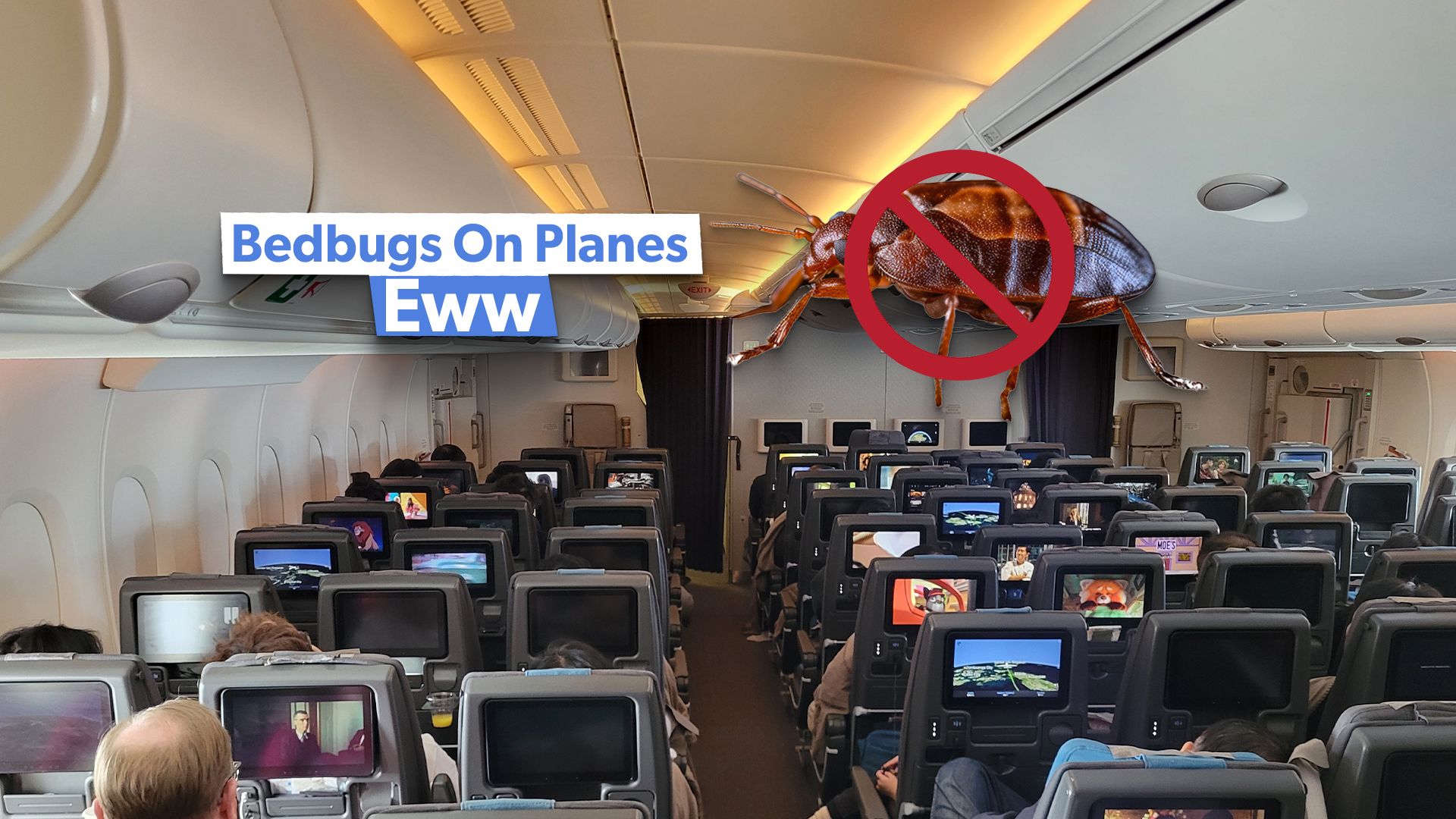While we hear about bed bugs in hotels or hostels all too often, how often do these creepy crawlies make it onto aircraft? When you think about it, planes and hotels have a lot in common: different guests almost every day of the week.
Bed bugs on a plane and how to get rid of them
First and foremost, it’s important to recognize that airlines have stringent cleaning routines. However, as you can expect, with airlines operating their aircraft to their ultimate capacity, sometimes things can be missed. However, at what point do airlines need to put health and sanitation before profit?
Recently, as reported by Simple Flying, a ![]() Turkish Airlines
Turkish Airlines
flight was found with a bed bug onboard; a passenger was advised by their neighbor that a bed bug had appeared, and when they advised the flight attendant, it was allegedly brushed off.
Previously, as per an article by the New York Post, ![]() British Airways
British Airways
cabin crew said, ‘Enough is enough’ when they spotted several bed bugs crawling on the seats in the cabin, noting that it was ‘unacceptable to work on that aircraft’; the crew downed tools and walked off the job just minutes before their duty timed out.
Unfortunately for the first class traveler, be warned that bed bugs don’t care what cabin you fly; if the plane is infested with these creepy crawlies, they could also opt for flying in the premium cabins, and it’s not just isolated to the aircraft itself, bed bugs can make their way into airport terminals and lounges.

Related
Turkish Airlines Passengers Encounter Bedbugs On 3 Flights
Passengers have come forward with their stories of bedbugs on the flights.
Not just a problem for Paris
Many of us will recall the Paris bedbug infestation, which saw these unwelcome insects infest many hotels around the city of love. Fortunately, the infestation remained within the city’s boundaries and is now under control.
While the recent reports of these creepy crawlies on a Turkish Airlines flight have made some of our stomachs churn, it’s not the first time the carrier has faced such an issue. The carrier, based at  Istanbul Airport
Istanbul Airport
(IST), is the largest carrier in the world by international countries served, and due to its unique location on the edge of Europe and Asia, has seen the carrier benefit from a vast network of destinations within its reach.
Turkish Airlines, Turkey’s flag carrier, operates scheduled services to 352 global destinations (including cargo) across Europe, Asia, Oceania, Africa, and the Americas. From its home at Istanbul Airport, the carrier flies passenger services to 131 countries, more than any other carrier. The airline also has several fully owned and part-owned subsidiaries that support its operations. The carrier has been part of the ![]() Star Alliance
Star Alliance
since April 1, 2008. According to Forbes, the airline employes more than 40,000 staff, which encompasses those both on the ground, and in the air.

Related
Inside Turkish Airlines: Live Animal Transport
TK Live transports animals such as cats, dogs, cattle, snakes, and even a whale!
How hard is it to remove bed bugs from an airplane?
Airlines usually have a periodic cleaning schedule that is in place to ensure satisfactory levels of hygiene and safety for those onboard (that includes passengers and crew). When a flight touches down, it will be cleaned by a dedicated crew or the cabin crew. When a plane may be visiting a foreign port, these cleaners could be contracted in, compared to an aircraft returning to its home base, where the airline itself will have its cleaning team that should sanitize the aircraft from tip to toe.
Photo: Matheus Obst | Shutterstock
In the case of bedbugs, these are a general issue seen across public spaces. Turkish Airlines, in their recent bed bug fiasco, saw the airline released this statement to Simple Flying to reassure passengers:
“As part of our routine operations, our aircraft are regularly cleaned and thoroughly sanitized before every flight. We also maintain close communication with aircraft manufacturers to ensure the most effective and safe disinsection procedures are implemented.
Turkish Airlines prioritizes the safety and comfort of its passengers at all times and diligently takes all necessary measures in this regard.”
Between flights, galleys and lavatories are usually serviced, along with trash removal. When the aircraft has finished its flight cycles for the day, it will undergo a thorough cleaning, such as wiping down passenger seats and seatback table trays, ensuring the aircraft is in a tidy condition before re-starting services the next morning.
In addition to routine cleaning, aircraft can be grounded and their seats removed to ensure a deep clean. Specialist cleaning crews will detail the seat compartments, cabinets, and storage areas; specialist equipment can be brought in to aid in this deep clean. If bedbugs have made themselves onto an aircraft, they will likely hide in the crevices between seats.

Related
What Are The 3 Different Ways An Aircraft’s Interior Can Be Cleaned?
Aircraft can be given anything from a lightning-quick surface clean to a deep clean, which involves taking the seats out to acces the inner workings.
How do airlines manage bug infestations?
Suppose an airline can detect an infestation early. In that case, pest control can be inexpensive, but unfortunately for many, identifying an early infestation can be difficult, mainly if you are operating flights back to back.
Bed bugs are challenging to spot with the naked eye, as they can be only two millimeters long and translucent when not gorged with blood. Bedbugs can go up to a week without food and can be found traveling on people’s luggage or furniture. Hiding in cracks, these bugs look to feed at night by biting humans as they sleep. If you are bitten, it’s unlikely you will feel it, and symptoms may only appear several weeks later, with similar symptoms being that of mosquitos, scabies, or other allergens.
Photo: Air Japan
For passengers, there are several steps you can take to ensure that you avoid any unwanted visitors in flight. These are:
- Pick a suitcase with smooth and hard surfaces. If your bag has fabric pockets, then they can provide the perfect habitat for bed bugs to hitch a ride
- Dry cleaning your suitcase and other items will kill bed bugs and any eggs
- Keep your luggage away from sleeping or rest areas
- Check nooks and crannies for evidence of bugs
If you think you may have been exposed to bed bugs, let your cabin crew know immediately so they can exterminate them.
How to exterminate a bed bug infestation
While 100% elimination could be near impossible, it is manageable to maintain a stringent cleaning cycle to ensure you remain clear. Airlines can use different pesticides to kill bugs onboard, and the most common are liquids or aerosols sprayed directly onto surfaces. These will vary between airlines, but all should meet the requirements to be safe for incoming passengers or crew.
As the Beat of Hawaii noted in 2023, US airlines are immune to this bed bug dilemma. Southwest Airlines saw its Honolulu terminal exposed to bed bugs. For the Hawaiian Department of Transportation, mitigating the infestation took over a month.
We can sanitize our luggage to limit bedbugs and ensure downtime after use (i.e., don’t use the same bag consecutively). Another suggestion is to store items inside sealable plastic bags.
What can flight attendants do to limit bug infestations onboard?
Flight attendants’ capacity to manage any identifiable bug infestation onboard will be limited by the time and supplies available onboard. Flight attendant unions have provided several recommendations to encourage crew to pack disposable latex gloves and flashlights to search small nooks or crannies that are areas of concern.
Photo: Austin Deppe | Shutterstock
US carrier American Airlines has seen its share of bedbug infestations, including multiple complaints from passengers and crew who experienced bites on its Boeing 777 and 787 aircraft last October.

Related
American Airlines Flight Diverts To Phoenix After Lice Found In Passenger’s Hair
The incident occurred on June 15th when an A321neo bound for JFK diverted to Phoenix just two hours after departing from Los Angeles.
What can we do to stop bedbugs from following us home?
As mentioned, choosing the right suitcase is the first step in limiting bed begs to catch a ride home with you. Select a hard-shelled bag with smooth surfaces that limit any nooks or crannies that bed bugs can hide. Sanitizing your bag with cleaners or having these steam cleaned after use usually kills parasites. Laundering your clothes after travel is a prudent way to limit bed bug infestations.
Photo: Romeo PJ | Shutterstock
Bedbugs are usually found on longer overnight flights due to passengers being asleep and minimal movement or disturbance, which leads to the insects coming out of cracks or crevices. Therefore, they are usually limited to long-haul flights. However, this does not mean you aren’t immune to them on commuter services.
Other steps that you can take to limit your exposure to parasites when flying are ensuring that you keep your seating area clean, which includes disposing of any unwanted food items as soon as you are finished and picking up any loose food items that land on the floor.





